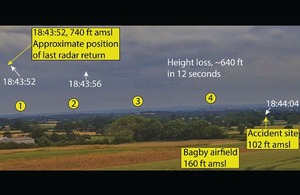AAIB Report: Piper PA-23-250, G-BKJW
Fatal accident involving a Piper PA-23-250, G-BKJW, 1 nm south-west of Bagby Airfield, North Yorkshire, 6 July 2023

Composite CCTV image of G-BKJW descent into terrain
The pilot had departed Bagby airfield in the morning and flown to Deauville in France where he collected five passengers and delivered them to Abbeyshrule in Ireland. The accident occurred at the end of the return flight to Bagby, with the pilot the sole occupant of the aircraft. After the pilot made a normal radio call to Bagby to say that he was four miles from the airfield, the aircraft was seen on radar and CCTV to join right base for Runway 06. The CCTV video showed the aircraft鈥檚 descent angle start to steepen while it was on right base. There was then a slight reduction in descent angle before the descent angle steepened sharply and the aircraft struck trees and then the ground at an angle of about 35掳 to 40掳 nose-down, with no indication that the aircraft was starting to recover. The ground impact caused a fire, and the accident was not survivable.
The post-impact fire destroyed a significant amount of physical evidence, but that which remained contained no identifiable defects that could have caused or contributed to the nose-dive. The one anomaly found was the position of the pitch trim drum which was 3 mm from the full nose-down position. Evidence from a flight trial on the same type of aircraft revealed that this was more nose-down than would be expected for any flap configuration in the speed range determined from the CCTV. However, the possibility of the trim having moved during the post-impact break-up could not be discounted, so other theories of what could have caused the final nose-dive were considered. Of all the causes reviewed, a pitch trim runaway was considered to be the most likely, but there was insufficient evidence to determine that it was the definitive cause of the accident.
In conducting the investigation, it was apparent that although occurrences of pitch trim runaway are rare, when they do occur the results can easily be catastrophic, particularly if it occurs at low altitude where there is limited time to respond. Irrespective of whether a pitch trim runaway was the cause of the accident to G-BKJW, the investigation identified ways to reduce the risk of such an event. Consequently, the CAA plan eight safety actions which concern:
- Training for a pitch trim runaway.
- Deactivating inoperative autopilots.
- Making autopilot and electric trim circuit breakers more visible.
- Providing clearer information regarding differences training requirements.